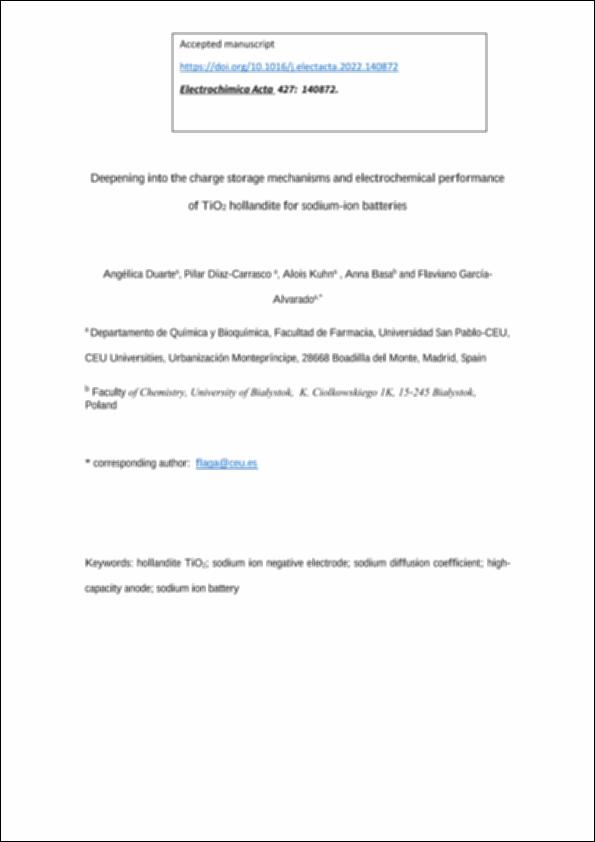Please use this identifier to cite or link to this item:
http://hdl.handle.net/10637/16093Deepening into the charge storage mechanisms and electrochemical performance of TiO2 hollandite for sodium-ion batteries
| Title: | Deepening into the charge storage mechanisms and electrochemical performance of TiO2 hollandite for sodium-ion batteries |
| Authors : | Díaz Carrasco, Pilar Kuhn, Alois Duarte, Angélica Basa, Anna García Alvarado, Flaviano |
| Keywords: | Hollandite TiO2; Sodium ion negative electrode; Sodium diffusion coefficient; High-capacity anode; Sodium ion battery |
| Publisher: | Elsevier |
| Citation: | Duarte-Cárdenas, A., Díaz-Carrasco, P., Kuhn, A., Basa, A., & García-Alvarado, F. (2022). Deepening into the charge storage mechanisms and electrochemical performance of TiO2 hollandite for sodium-ion batteries. Electrochimica Acta, 427, 140872. 10.1016/j.electacta.2022.140872 |
| Abstract: | The electrochemical performance of TiO2 hollandite, TiO2(H), obtained by complete K+ ion extraction of the bronze K0.2TiO2 is investigated. TiO2 develops a fairly stable capacity of 106 mAh g–1 after 300 cycles at C/8 (42 mA g–1) and maintains 100 mAh g–1 after 600 cycles. At high current rate (2C, 671 mA g–1) 55 mAh g–1 is still maintained. Cycling produces nanosizing of the TiO2 electrode (to 200–300 nm) by electrochemical milling but cyclic voltammetry at different sweep rates indicates that diffusive controlled faradic contribution to the total capacity of TiO2(H) due to Na insertion is significant even at high current. However, participation of pseudocapacitive charge storage is unveiled. The voltage profile resembles in fact that of pseudocapacitive materials with no clear evidence of a constant voltage region. Operando XRD confirmed the lowering of symmetry from tetragonal I4/m to monoclinic I2/m upon sodiation with a relatively narrow two-phase region different from other long plateaus of typical battery materials. Cyclic voltammetry clearly indicates that the two peaks (centered at 1.25 and 0.5 V on reduction) correspond to diffusion-limited faradic processes. Thus, it can be said that hollandite TiO2 is a battery-like material, but for which kinetics is not limited by a biphasic transformation. Instead, kinetics is limited mainly by slow diffusion in single phases with variable composition (continuous variation of voltage vs. capacity) that are formed upon Na+ intercalation into the tunnels. The limited diffusion at high sweep rate favors the dominance of pseudocapacitance (charge transfer at the surface). A comparison with the bronze K0.2TiO2 reveals the importance of potassium in the electrochemical properties and the nature of the different physicochemical processes of both compounds. Sodium ion diffusion coefficient in TiO2(H), 2.6 · 10–13 cm2 s–1, is several orders of magnitude higher than that of TiO2 rutile and anatase, however it does not provide a fast intercalation into the tunnels to consider it a pseudocapacitive intercalation material. |
| Description: | Este artículo es la versión aceptada siguiendo la política de la revista |
| URI: | http://hdl.handle.net/10637/16093 |
| Rights : | http://creativecommons.org/licenses/by-nc-nd/4.0/deed.es |
| ISSN: | 0013-4686 |
| Issue Date: | Sep-2022 |
| Center : | Universidad San Pablo-CEU |
| Appears in Collections: | Facultad de Farmacia |
Items in DSpace are protected by copyright, with all rights reserved, unless otherwise indicated.


